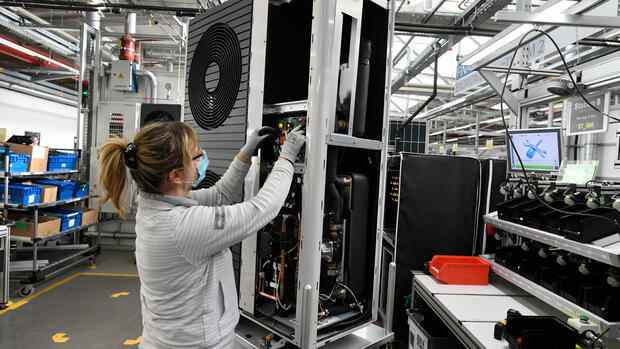Industry is investing billions in expanding production capacities.
(Photo: dpa)
Berlin The number of heat pumps installed in Germany for heating buildings is increasing rapidly. In September 2022, 69 percent more heat pumps were installed than in the same month last year. This is shown by figures from the industry associations.
A total of around 230,000 heat pumps are likely to be installed this year, significantly more than the 154,000 devices in the previous year. Economics Minister Robert Habeck (Greens) therefore sees clear signs that the electric heat pump is becoming the standard solution in Germany.
Habeck spoke on Wednesday at the end of the second heat pump summit, to which he had invited industry representatives, of a “comparatively steep ramp-up”.
Habeck is convinced that heat pumps are the ideal solution for significantly reducing CO2 emissions in the building sector. They use the temperature of the surrounding air and electricity to generate heat and use it to operate heating systems. His goal is to increase the number of heat pumps to six million by 2030. There are currently 1.5 million heat pumps in use in Germany.
Top jobs of the day
Find the best jobs now and
be notified by email.
“The production side will manage the ramp-up,” said Habeck. That was not certain at the first heat pump summit at the end of June.
In the meantime, the manufacturers have announced massive investments. According to Jan Brockmann, member of the board of the Federal Association of the Heating Industry (BDH) and head of Bosch Thermotechnik, the companies will invest three to four billion euros in heat pump technology. According to Brockmann, the amount for his company alone amounts to 700 million euros.
Six million heat pumps are to be running by 2030
In order to reach the goal of six million heat pumps, the number of heat pumps used in Germany must continue to rise sharply in the coming years. 350,000 devices are to be installed in 2023, and 500,000 in 2024. According to Martin Sabel, Managing Director of the German Heat Pump Association (BWP), the goals are “achievable”.
The challenges do not only include ramping up production. Qualified employees who can install the systems are also scarce. The plumbing industry has long pointed out that it lacks people. The Federal Ministry of Economics is trying to get this problem under control with special funding programs and qualification campaigns.
The Economics Minister sees the goal of six million heat pumps by 2030 as still within reach.
(Photo: dpa)
The industry also insists on continuing to provide comprehensive and reliable public funding for the installation of heat pumps. The installation can currently be supported with a subsidy of up to 30 percent. Heat pumps are still significantly more expensive to purchase than fossil-fuelled devices.
>> Read also: For whom is a heat pump worthwhile?
Habeck said he was in favor of using the “super depreciation” for investments in climate protection technology provided for in the coalition agreement to support the ramp-up of heat pumps. Habeck is hoping for a further boost for the heat pump from the regulation planned from 2024 that the renewable share in heating must be at least 65 percent. In many cases, the heat pump may be the only technology that can meet this requirement.
Heat pumps challenge the power grid
Critics warn against a one-sided commitment to the heat pump. They point out that although the heat pump is usually the best solution in well-insulated new buildings, its efficiency advantages cannot be exploited in poorly insulated existing buildings.
In addition, widespread use of heat pumps would place a heavy load on the power supply system. According to the Energy Economics Institute at the University of Cologne (EWI), six million heat pumps mean an electricity demand of around 30 terawatt hours.
According to the EWI, on a very cold winter day, such a number of heat pumps would increase the peak load in Germany by up to ten gigawatts. To put this in perspective: the net electricity consumption in Germany in 2021 was around 508 terawatt hours. The term peak load refers to the moment with the highest demand for electricity. In Germany, the peak load is a good 80 gigawatts (GW).
More: Is a balcony solar system worth it?
